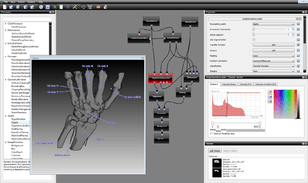Voreen
 | |
 The development mode in Voreen allows rapid prototyping of interactive volume visualizations. | |
| Stable release | 4.3 / June 14, 2013 |
|---|---|
| Written in | C++, OpenGL, GLSL, OpenCL. Python |
| Operating system | Cross-platform |
| Type | Volume rendering, Interactive visualization |
| License | GNU General Public License Version 2 |
| Website | voreen.uni-muenster.de |
Voreen (volume rendering engine) is an easy to use and highly flexible open source volume visualization library and development platform. Through the use of GPU-based state-of-the-art volume rendering techniques it allows high frame rates on standard graphics hardware to support interactive volume exploration.
History
Voreen has been initiated at the Department of Computer Science at the University of Münster, Germany in 2004 and was first released on 11 April 2008 under the GNU general public license (GPL). Voreen is written in C++ using the OpenGL graphics library, and is able to achieve high interactive frame rates on consumer graphics hardware.[1] It is platform independent and compiles on Windows, Linux and Mac OS X. The source code and documentation, and since July 2009 also pre-compiled binaries for Windows and Mac OS X, are available from its website and via Subversion. Although it is intended and mostly used for medical applications,[2] any other kind of volume data can be handled, e.g., microscopy, flow data or other simulations.[3]
Concepts
The visualization environment VoreenVE based on that engine is designed for authoring and performing interactive visualizations of volumetric data. Different visualizations can be assembled in form of so called networks via rapid prototyping, with each network consisting of several processors.[4] Processors perform more or less specialized tasks for the entire rendering process, ranging from supplying data over raycasting, geometry creation and rendering to image processing. Within the limits of their respective purposes, the processors can be combined freely with each other, and thereby granting a great amount of flexibility and providing a uniform way of handling volume rendering. Authors who need to implement a certain rendering technique can confine their work basically on the development of new processors, whereas users who only want to access a certain visualization simply need to employ the appropriate processors or networks and do not need to care about technical details.
Features
Visualization
- Direct volume rendering (DVR), isosurface rendering, maximum intensity projection (MIP)
- Support of different illumination models (Phong reflection model, tone shading, ambient occlusion)
- Interactive internal and external labeling
- Flexible combination of image processing operators (depth darkening, glow, chromadepth, edge detection)
- Glyph-based visualization of multimodal datasets (not yet publicly available)
- Visualization of time-varying as well as segmented 3D datasets
- Support for 1D and 2D transfer functions/CLUTs
Interaction
- Up to 6 axis aligned clipping planes
- Editors for 1D and 2D transfer functions
- Editable lighting and material parameters
- Distance measurements (not yet publicly available)
Data I/O
- Support for several volume file formats (DICOM, TIFF stacks, RAW, interfile, Vevo, …)
- Preprocessing capabilities (volume cropping, gradient calculation, downscaling, filtering)
- High-resolution screenshot and camera animation generation with anti-aliasing
- Python scripting for offline image processing and visualization
See also
References
- ↑ Smelyanskiy, M.; Holmes, D.; Chhugani, J.; Larson, A.; Carmean, D. M.; Hanson, D.; Dubey, P.; Augustine, K.; Kim, D.; Kyker, A.; Lee, V. W.; Nguyen, A. D.; Seiler, L.; Robb, R. (2009). "Mapping High-Fidelity Volume Rendering for Medical Imaging to CPU, GPU and Many-Core Architectures" (PDF). IEEE Transactions on Visualization and Computer Graphics 15 (6): 1563–1570. doi:10.1109/TVCG.2009.164. ISSN 1077-2626. PMID 19834234.
- ↑ Eisenmann, U.; Freudling, A.; Metzner, R.; Hartmann, M.; Wirtz, C. R.; Dickhaus, H. (2009). Volume Rendering for Planning and Performing Neurosurgical Interventions. "World Congress on Medical Physics and Biomedical Engineering, September 7 - 12, 2009, Munich, Germany". IFMBE Proceedings. IFMBE Proceedings 25/6: 201–204. doi:10.1007/978-3-642-03906-5_55. ISBN 978-3-642-03905-8. ISSN 1680-0737.
- ↑ "Flight through Rayleigh-Benard field".
- ↑ Meyer-Spradow, J.; Ropinski, T.; Mensmann, J. R.; Hinrichs, K. (2009). "Voreen: A Rapid-Prototyping Environment for Ray-Casting-Based Volume Visualizations". IEEE Computer Graphics and Applications 29 (6): 6–13. doi:10.1109/MCG.2009.130. ISSN 0272-1716.
External links
| |||||||||||||||||||